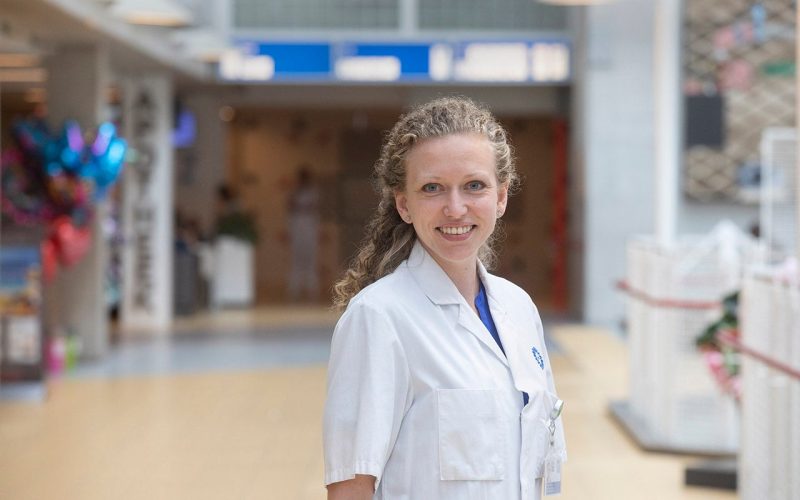Heart muscle disease ARVC is usually detected around the age of 35, mostly in athletic people. It often involves severe arrhythmias, sometimes even sudden cardiac death. In two-thirds of patients, the cause is found in the DNA. “That predisposition is almost always inherited from generation to generation, even if by no means all family members have symptoms,” says physician-researcher Freyja van Lint. “That’s insidious. DNA testing in the family is important. Early detection can prevent serious symptoms.”
In the heart muscle disease ARVC (Arrhythmogenic Right Ventricular Cardiomyopathy), the heart muscle has been partially replaced by connective and fatty tissue. As a result, there is an increased risk of cardiac arrhythmias. These can be life-threatening. ARVC is responsible for several cases of sudden cardiac death annually in people under the age of forty in the Netherlands. Some of them are apparently healthy young athletes. ARVC occurs in one in a thousand to five thousand people.
ARVC is diagnosed on the basis of abnormalities on cardiac ultrasound (ECG), ultrasound, MRI scan, Holter examination and exercise testing. Patients with ARVC come under the control of the cardiologist. Often the patient is prescribed living rules, such as avoiding intense exercise and competitive sports. Arrhythmias are usually treatable with medication. If the risk of a dangerous arrhythmia is increased, a patient may be fitted with an ICD (internal cardioverter defibrillator) may be implanted. If the heart rhythm does not recover on its own after a disorder, this device delivers a power surge. This can prevent sudden death. In very severe cases, a heart transplant may eventually be necessary.
In two-thirds of people with ARVC, an inherited predisposition is found in the DNA, a mutation. “Our research now shows that in 99 percent of carriers that predisposition has been in the family for generations, even though by no means everyone has symptoms,” says physician-researcher Freyja van Lint of UMC Utrecht. “That’s insidious. This is because a mutation for ARVC can lead to severe arrhythmias and even sudden cardiac death at a young age, while with prevention and treatment many symptoms can be prevented or controlled. Therefore, if an inherited predisposition to ARVC is identified, the advice is to undergo broad DNA testing in the family.
To date, sixty percent of family members of an ARVC patient with a hereditary predisposition still do not report for DNA testing, even though they are invited to do so. “The thinking is still sometimes: father and grandfather are already fifty and eighty and have no symptoms, so there is no need. But grandparents, fathers and mothers, aunts and uncles can be carriers. So DNA testing is also valuable with older family members,” emphasizes Professor of Clinical Genetics Peter van Tintelen (UMC Utrecht). Not everyone with a hereditary predisposition for ARVC becomes ill. The degree of illness also varies. “Then it often seems as if nothing is wrong, while with this mutation there is a fifty percent chance that you pass it on to children or grandchildren through your DNA,” he says. It is therefore important that family members get tested for the predisposition and go to the cardiologist for checkups, even if they appear healthy.
The researchers examined how often ARVC is inherited or a newly arising mutation in the DNA. To do so, they examined the records of 501 ARVC patients who were the first in their families to have the disease and became patients at one of the eight UMCs in the Netherlands, the University Hospital of Münster (Germany) or that of Johns Hopkins (Baltimore, USA). To determine inheritance, the study looked at whether family members also have the mutation. Van Lint: “Almost 99 percent of the patients had inherited the mutation. Only a few had a new mutation.” This study also found that few family members were tested for the mutation, even though they are at risk of getting the disease or passing on the mutation.
The researchers found that 183 families with ARVC had 24 of the same mutations. This study compared the DNA of these families by measuring the haplotype: a group of genes that inherit together. “If several families have the same haplotype, then they are descended from the same distant ancestor,” Van Lint explains. “We saw that even families from very different countries shared the same haplotype. This means that the predisposition for ARVC is then passed down for generations.”
This research was supported by the Heart Foundation, Netherlands Heart Institute and the Netherlands Organization for Scientific Research (NWO). An article about it was published in Circulation: Genomic and Precision Medicine.
